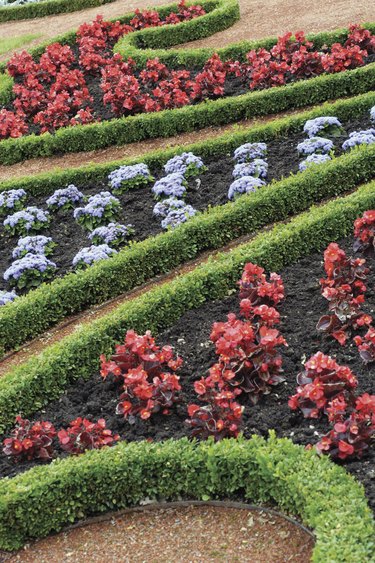
Boxwood (Buxus sempervirens) is a woody shrub favored for its fine-leaf evergreen foliage. This perennial plant grows in U.S. Department of Agriculture plant hardiness zones 6 through 8. Boxwood is a low-maintenance shrub with dense foliage suitable for hedges. Boxwood hedges have shallow root systems that benefit from organic mulch and commercial fertilization.
Features
Video of the Day
Boxwood hedges grow slowly in rounded shapes. Maturing at 8 to 15 feet high, hedges spread as dense screens. Boxwood hedges tolerate pruning and shaping well, adapting to formal box hedges or informal mounding shapes. The hedges grow in full sun, but favor part shade locations. These hedges need well-drained soil and good air circulation as they are vulnerable to root rot and fungal diseases.
Video of the Day
Mulching
Due to their shallow root systems, boxwood hedges benefit from organic mulch. The mulch moderates soil temperature, minimizes water evaporation and protects the roots from wind and water erosion. Mulch such as shredded hardwood bark is applied in a thin layer, 1 to 2 inches deep, under the hedges outward to the drip-line. Keep mulch at least 4 to 6 inches from the boxwood trunk to prevent disease and trunk softening. As the mulch decomposes, it provides fertilizer to the roots.
Soil Testing
Because boxwood hedges can be fussy about their soil, the American Boxwood Society recommends soil testing. The shrubs prefer slightly acid to slightly alkaline soil, meaning an optimum pH in the 6.5 to 7.2 range. When the level is low, fertilize with dolomite lime at the analysis recommended rates. When the level is high, fertilize with iron sulfate in accordance with test results. These fertilizers are sprinkled over the mulch around the drip-line as the active roots are at the outer edges of the branches.
Fertilizer
Use a balanced fertilizer in lieu of soil tests. Broadcast a 10-10-10 fertilizer over the mulch in late winter or early spring for root development. A time-release granular fertilizer, applied at the rate of 1 pound per 100 square feet, works for several months, although second applications may be needed for sandy or infertile soils. Apply fertilizer over the mulch around the drip-line, avoiding the trunk area and exposed roots. Because the boxwood hedges are evergreens, their leaves remain on the branches year-round. Yellowing leaves on the lower edges of the plants or leaves dropping off early may be signs of nitrogen deficiency. Apply a balanced fertilizer over the mulch and water it well to boost the nitrogen level and stimulate green foliage.
- American Boxwood Society: About Boxwood
- North Carolina State University; Growing Boxwoods in the Landscape; Erv Evans, et al.; February 1999
- Virginia Cooperative Extension; Boxwood in the Landscape; Diane Relf, et al.; May 2009
- University of Florida Extension; Buxus Sempervirens; Edward F. Gilman; October 1999